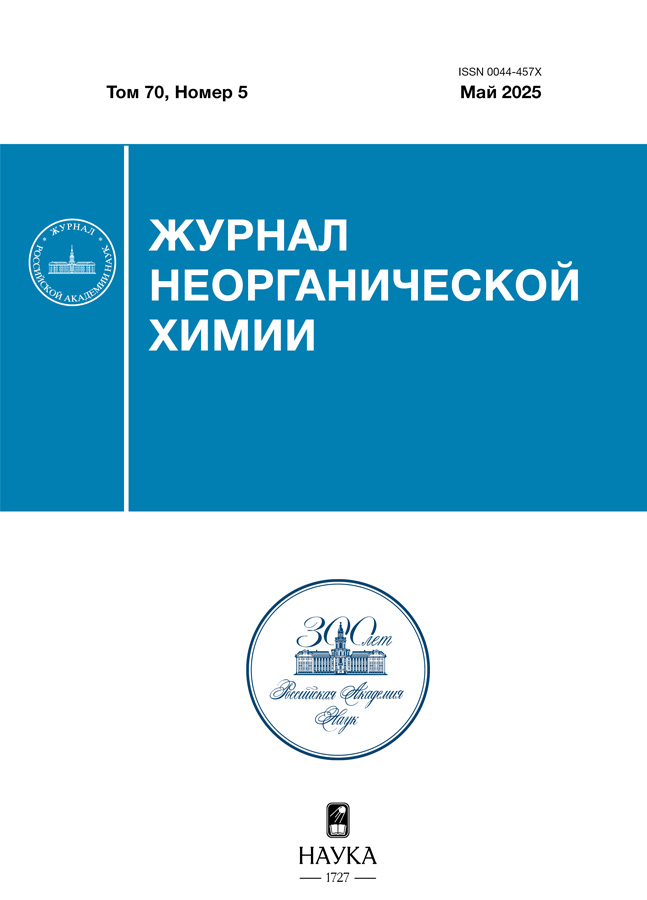Sensory properties of h-WO3 doped with Co2+ and Fe3+ cations in relation to toxic gases
- Authors: Podval'naya N.V.1, Marikutsa A.V.2, Zakharova G.S.1
-
Affiliations:
- Institute of Solid State Chemistry, Ural Branch of the Russian Academy of Sciences
- Lomonosov Moscow State University
- Issue: Vol 70, No 5 (2025)
- Pages: 617-629
- Section: СИНТЕЗ И СВОЙСТВА НЕОРГАНИЧЕСКИХ СОЕДИНЕНИЙ
- URL: https://ruspoj.com/0044-457X/article/view/685434
- DOI: https://doi.org/10.31857/S0044457X25050011
- EDN: https://elibrary.ru/HXVUIM
- ID: 685434
Cite item
Abstract
The sensory properties of solid solutions of h-CoxWO3 (0 ≤ x ≤ 0.09) and h-W1–xFexO3 (0 ≤ x ≤ 0.06), as well as m-WO3, were studied in relation to various toxic gases at the maximum permissible concentrations in the air. Doping of h-WO3 with Co2+ or Fe3+ ions does not affect the sensitivity of the sensory response to CH3COCH3 and NH3, but leads to a decrease in the sensory signal relative to NO2. A comparative analysis of the sensory properties of tungsten trioxide of hexagonal and monoclinic crystallographic modification has been performed. When detecting CH3COCH3 and NH3, the sensitivity of h-WO3 is 1.5 and 1.3 times higher than that of m-WO3, respectively. The oxygen vacancy concentration and pore volume are key parameters that determine the higher sensitivity of m-WO3 to NO2 compared to h-WO3.
Full Text
About the authors
N. V. Podval'naya
Institute of Solid State Chemistry, Ural Branch of the Russian Academy of Sciences
Author for correspondence.
Email: podnat@inbox.ru
Russian Federation, Pervomaiskaya str., 91, Yekaterinburg, 620990
A. V. Marikutsa
Lomonosov Moscow State University
Email: podnat@inbox.ru
Faculty of Chemistry
Russian Federation, Leninskie Gory, 1–3, Moscow, 119234G. S. Zakharova
Institute of Solid State Chemistry, Ural Branch of the Russian Academy of Sciences
Email: podnat@inbox.ru
Russian Federation, Pervomaiskaya str., 91, Yekaterinburg, 620990
References
- Li. Z.J., Li H., Wu Z.L. et al. // Mater. Horiz. 2019. V. 6. № 3. P. 470. https://doi.org/10.1039/C8MH01365A
- Wang H., Lusting W.P., Li J. // Chem. Soc. Rev. 2018. V. 47. № 13. P. 4729. https://doi.org/10.1039/C7CS00885F
- Rezvani S.A., Soleymanpour A. // Microchem. J. 2019. V. 149. P. 104005. https://doi.org/10.1016/j.microc.2019.104005
- Yoon J.W., Lee J.H. // Lab. Chip. 2017. V. 17. № 21. P. 3537. https://doi.org/10.1039/C7LC00810D
- Broza Y.Y., Vishinkin R., Barash O. // Chem. Soc. Rev. 2018. V. 47. № 13. P. 4781. https://doi.org/10.1039/C8CS00317C
- Mustafa F., Andreescu S. // Foods. 2018. V. 7. № 10. P. 168. https://doi.org/10.3390/foods7100168
- Yunusa Z., Hamidon M.N., Kaiser A. et al. // Sensors Transducers. 2014. V. 168. № 4. P. 61. https://sensorsportal.com/HTML/ST_JOURNAL/PDF_Files/P_1957.pdf
- Xing J., Lin Z., Zhou J. et al. // Mater. Lett. 2019. V. 244. P. 182. https://doi.org/10.1016/j.matlet.2019.01.148
- Wetchakun K., Samerjai T., Tamaekong N. et al. // Sens. Actuators, B. 2011. V. 160. № 1. P. 580. http://dx.doi.org/10.1016/j.snb.2011.08.032
- Dey A. // Mater. Sci. Eng. B. 2018. V. 229. P. 206. https://doi.org/10.1016/j.mseb.2017.12.036
- Dong C., Zhao R., Yao L. et al. // J. Alloys Compd. 2019. V. 820. P. 153194. https://doi.org/10.1016/j.jallcom.2019.153194
- Huang Z.-F., Song J., Pan L. et al. // Adv. Mater. 2015. V. 27. № 36. P. 5309. https://doi.org/10.1002/adma.201501217
- Бушкова Т.М., Егорова А.А., Хорошилов А.В. и др. // Журн. неорган. химии. 2021. Т. 66. № 4. С. 470. https://doi.org/10.31857/S0044457X21040073
- Solarska R., Alexander B.D., Braun A. et al. // Electrochim. Acta. 2010. V. 55. № 26. P. 7780. https://doi.org/10.1016/j.electacta.2009.12.016
- Shannow R.D. // Acta Crystallogr., Sect. A. 1976. V. 32. № 5. P. 751. https://doi.org/10.1107/S0567739476001551
- Faisal M., Javed I., Tarid J. et al. // J. Alloys Compd. 2017. V. 728. P. 1329. https://doi.org/10.1016/j.jallcom.2017.08.234
- Gao H., Zhu L., Peng X. et al. // Appl. Surf. Sci. 2022. V. 592. 153310. P. 153310. https://doi.org/10.1016/j.apsusc.2022.153310
- Zhang Z., Hag M., Wen Z. et al. // Appl. Surf. Sci. 2018. V. 434. P. 891. http://dx.doi.org/10.1016/j.apsusc.2017.10.074
- Renitta А., Vijayalakshmi K. // Catal. Commun. 2016. V. 73. P. 58. https://doi.org/10.1016/j.catcom.2015.10.014
- Liu Z., Liu B., Xie W. et al. // Sens. Actuators, B. 2016. V. 235. P. 614. https://doi.org/10.1016/j.snb.2016.05.140
- Lim J.C., Jin C., Choi M.C. et al. // Ceram. Int. 2021. V. 47. № 15. P. 20956. https://doi.org/10.1016/j.ceramint.2021.04.095
- Jia Q., Ji H., Gao P. et al. // J. Mater. Sci - Mater Electron. 2015. V. 26. P. 5792. https://doi.org/10.1007/s10854-015-3138-5
- Hernandez-Uresti D.B., Sánchez-Martínez D., Martínez-de la Cruz A. // Ceram. Int. 2014. V. 40. № 3. P. 4767. https://doi.org/10.1016/j.ceramint.2013.09.022
- Zakharova G.S., Podval’naya N.V., Gorbunova T.I. et al. // J. Alloys Compd. 2023. V. 938. P. 168620. https://doi.org/10.1016/j.jallcom.2022.168620
- Захарова Г.С., Подвальная Н.В., Горбунова Т.И. и др. // Журн. неорган. химии. 2023. Т. 68. № 4. С. 435. https://doi.org/10.31857/S0044457X22602127
- Захарова Г.С., Подвальная Н.В., Горбунова Т.И. и др. // Журн. неорган. химии. 2024. Т. 69. № 8. С. 1117.
- Al-Kuhaili M.F., Drmosh Q.A. // Mater. Chem. Phys. 2022. V. 281. P. 125897. https://doi.org/10.1016/j.matchemphys.2022.125897
- Sing K.S.W., Everett D.H., Haul R.A.W. et al. // Pure Appl. Chem. 1985. V. 57. № 4. P. 603. https://doi.org/10.1351/pac198557040603
- Gillet M., Lemire C., Gillet E. et al. // Surf. Sci. 2003. V. 532–535. P. 519. https://doi.org/10.1016/S0039-6028(03)00477-1
- Zhang C., Luo Y., Xu J. et al. // Sens. Actuators, A: Phys. 2019. V. 289. P. 118. https://doi.org/10.1016/j.sna.2019.02.027
- Korotcenkov G., Han S.-D., Cho B.K. et al. // Crit. Rev. Solid State Mater. Sci. 2009. V. 34. № 1–2. P. 1. https://doi.org/10.1080/10408430902815725
- Marikutsa A., Rumyantseva M., Konstantinova E.A. et al. // Sensors. 2021. V. 21. № 7. P. 2554. https://doi.org/10.3390/s21072554
- Staerz A., Berthold C., Russ T. et al. // Sens. Actuators B Chem. 2016. V. 237. P. 54. http://dx.doi.org/10.1016/j.snb.2016.06.072
- Amiri V., Roshan H., Miraei A. // Sensors. 2020 V. 20. P. 3096. https://doi.org/10.3390/2Fs20113096
- Wang M., Wang Y., Li X. et al. // Sens. Actuators, B: Chem. 2020. V. 316. P. 128050. https://doi.org/10.1016/j.snb.2020.128050
- Фаттахова З.А., Вовкотруб Э.Г., Захарова Г.С. // Журн. неорган. химии. 2021. Т. 66. № 1. С. 41. https://doi.org/10.31857/S0044457X21010025
Supplementary files



















